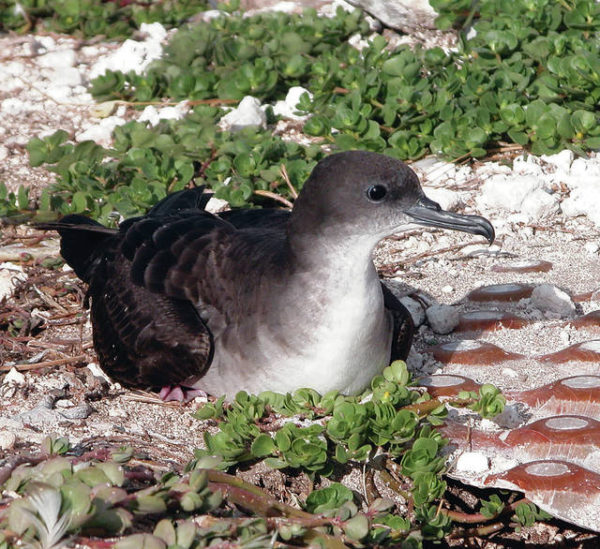Published in the Ocean Watch column, Honolulu Star-Advertiser © Susan Scott
November 24, 2018
I’m thankful I live on an island that shearwaters call home.
My love affair with these seabirds began in 1988 during my visit to Tern Island in the Northwestern Hawaiian Islands. The foot-long birds with velvety soft feathers, gray above and white below, loved nesting under the house, a former Coast Guard barracks on concrete blocks.
As night fell the house sounded like a field hospital of wounded soldiers — and their families. Some of the high-pitched calls reminded me of crying babies.
 A wedge-tailed shearwater on Oahu.
A wedge-tailed shearwater on Oahu.
©2018 Susan Scott
But those human-sounding moans and groans we sometimes hear at night in springtime Hawaii aren’t from suffering people. They’re shearwater love songs.
The main islands host several species of shearwaters. The most common on Kauai is called Newell’s shearwater, a species threatened due to habitat loss and introduced predators, such as cats and rats.
During fledging season, which is now, some young birds get confused by lights and fly inland rather than seaward. Kauai residents pitch in to help federal, state and private conservation workers rescue downed chicks that hit power lines and other obstacles.
Oahu hosts several colonies of the slightly larger wedge-tailed shearwaters, a species that nests at Black Point, Kaena Point and on most of Oahu’s offshore islands.
Wedgies, as they’re affectionately called by their many fans, are native to Hawaii but also range throughout the tropical Pacific and Indian oceans. While sailing in Australia, I often see them skimming over the wave tops, their wingtips just inches above the water, as they search for fish and squid.
In June, wedgie couples fertilize and lay eggs in ground burrows that they usually dig themselves. The birds aren’t fussy about housing and readily move into wooden, clay or pipe burrows that people build for them as a helping hand. Natural burrows are easy to see at Kaena Point, as are the chicks, currently sitting at or near the entrances of their tunnels as they prepare to leave home.
Kaena Point’s wedgie chicks have a clear flight path to the sea, but those at Black Point and nearby islands get disoriented by lights, go the wrong way and hit power lines. Often the collision only stuns them, and after some rest they can be successfully relaunched.
If you find a grounded wedgie, it’s OK to pick it up. The sweet-tempered birds aren’t aggressive, but since they might scratch you in fear, use a small towel to handle the bird. Use the towel as a rug for the youngster in a cardboard box with a lid full of air holes. Because the birds grew up in burrows, your bird will settle right down in a dark box.
Bring your shearwater to one of the following rescue sites: The Hawaii Wildlife Center, Sea Life Park, Kailua’s Feather and Fur Animal Hospital or the Hawaiian Human Society. Check the organizations’ websites for details.
During this holiday season, taking the time to rescue one of these birds will make you, too, thankful for the privilege of sharing our limited land with shearwaters.